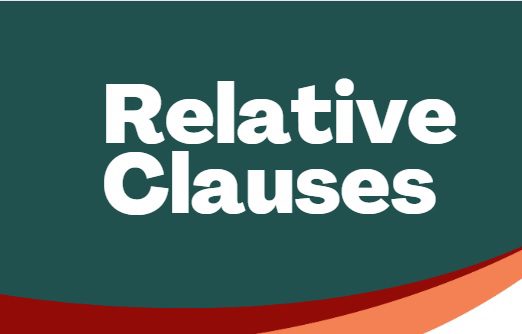Esta proposta de atividade de Língua Inglesa com base no DC/GO – Ampliado e é destinada aos estudantes do 8º Ano do Ensino Fundamental Anos Finais.

Understanding Relative Clauses
Relative clauses are an essential aspect of English grammar that add depth and detail to sentences. They provide additional information about a noun without starting a new sentence, making writing more fluent and nuanced.
What is a Relative Clause?
A relative clause is a type of dependent clause that modifies a noun or pronoun. It usually begins with a relative pronoun such as “who,” “whom,” “whose,” “which,” or “that.” Sometimes, it can start with a relative adverb like “where,” “when,” or “why.”
Types of Relative Clauses
- Defining (or Restrictive) Relative Clauses:
- These clauses are essential to the meaning of the sentence. They provide crucial information about the noun they modify.
- Example: “The book that you gave me is fascinating.”
- Here, “that you gave me” specifies which book is being talked about. Without this clause, the meaning of the sentence changes.
- Non-Defining (or Non-Restrictive) Relative Clauses:
- These clauses add extra information about the noun but are not essential to the overall meaning of the sentence. They are usually set off by commas.
- Example: “My brother, who lives in New York, is visiting us next week.”
- “who lives in New York” provides additional information about the brother. The main sentence “My brother is visiting us next week” still makes sense without it.
Relative Pronouns and Their Usage
- Who: Refers to people.
- Example: “The artist who painted this is famous.”
- Whom: Refers to people (used in formal contexts or when the person is the object of the clause).
- Example: “The person whom I met yesterday is a doctor.”
- Whose: Indicates possession.
- Example: “The writer whose book you read will be speaking tonight.”
- Which: Refers to animals and things.
- Example: “The car which I bought is very efficient.”
- That: Refers to people, animals, and things (often used in defining clauses).
- Example: “The song that you like is on the radio.”
Relative Adverbs and Their Usage
- Where: Refers to places.
- Example: “The restaurant where we had dinner was fantastic.”
- When: Refers to times.
- Example: “I remember the day when we first met.”
- Why: Refers to reasons.
- Example: “I don’t know the reason why she left.”
Punctuating Relative Clauses
- Defining relative clauses are not set off by commas.
- Example: “The man who called you is my uncle.”
- Non-defining relative clauses are set off by commas.
- Example: “Sarah, who is my best friend, moved to Canada.”
Omitting the Relative Pronoun
In some cases, the relative pronoun can be omitted, especially in defining relative clauses when it is the object of the clause.
- Example: “The book (that) you gave me is fascinating.”
- Here, “that” can be omitted without changing the meaning.
Conclusion
Relative clauses are a powerful tool in English grammar, allowing writers and speakers to provide additional details without creating choppy or disconnected sentences. By understanding and using defining and non-defining relative clauses, one can add clarity and richness to their communication.
Glossary:
- Relative Clause – Oração Relativa
- Dependent Clause – Oração Subordinada
- Noun – Substantivo
- Pronoun – Pronome
- Relative Pronoun – Pronome Relativo
- Relative Adverb – Advérbio Relativo
- Defining Clause – Oração Restritiva
- Non-Defining Clause – Oração Explicativa
- Possession – Posse
- Punctuation – Pontuação
- Omitting – Omissão
- Commas – Vírgulas
- Usage – Uso
- Essential – Essencial
- Additional Information – Informação Adicional
Leia o poema abaixo e responda as questões a seguir:
O poema de hoje abordará os pronomes relativos em português e em inglês
Palavrinhas curiosas e também muito graciosas,
Começamos pelo what que em português é o que,
Usado para perguntar por coisas ou animais
Poder usar esses pronomes é sempre bom demais
O Who em português é quem, usado para perguntar por pessoas
Sendo elas ruins ou boas
Where no nosso idioma é onde, usado para perguntar por lugares
Hum como é bom respirar novos ares
How para nós é como, esse já tem uso extenso
Pois seu uso como auxiliar é imenso
Temos how old que para nós se traduz qual idade
Para fazer essa pergunta tem q ter cumplicidade
How many é quantos em português, usado quando se quer saber quantidade
Esses pronomes mostram mesmo é muita curiosidade
How often em português é que frequência,
Pronome que em ambos idiomas tem muita influência
Tem também o which que traduzindo para português é qual,
Pronome que traz o sentido de escolha e seletividade
Usado para perguntar por coisas, animais ou pessoas em qualquer oportunidade
Que o uso dessas palavrinhas curiosas seja sempre para elaborarmos perguntas
Bondosas, afetuosas e proveitosas
Para que possamos também receber respostas charmosas, respeitosas e generosas.
E que nossa comunicação em qualquer idioma, local ou situação
Seja sempre com o melhor que tivermos no coração.
Complete as frases abaixo com o pronome relativo correto:
Question 1
No poema, o pronome relativo em inglês é utilizado para perguntar sobre lugares é
(A) who
(B) where
(C) what
(D) how
Question 2
Explique como o poema ilustra o uso dos pronomes relativos em português e em inglês, destacando as diferenças e semelhanças entre os dois idiomas. Use exemplos do poema para embasar sua resposta.
Question 3
Considerando o poema e a explicação dos pronomes interrogativos em português e inglês, como a autora utiliza esses elementos linguísticos para promover uma reflexão sobre a importância da comunicação respeitosa e generosa?
Question 4

Question 5
Encontre os pronomes relativos no caça palavras abaixo:
| Autoria | Profª Drª Sueidy Lourencio |
| Formação | Letras: Português/Inglês – Doutorado em Educação |
| Componente Curricular | Língua Inglesa |
| Habilidade | (EF08LI17-A) Distinguir pronomes relativos, who, which, that, whose, para construir períodos compostos por subordinação e empregá-los em situações de comunicação. |
| Referências | RELATIVE CLAUSES. Disponível em: https://worldenglishblog.com/relative-pronouns-your-complete-guide/ , acesso em 21, Set.2022. Disponível em: https://www.youtube.com/watch?v=yrghStkVN38 , acesso em 24, set. 2022. Disponível em: https://www.liveworksheets.com/worksheets/en/English_as_a_Second_Language_(ESL)/Relative_clauses/Relative_clause_pg2369066xv , acesso em 24, set. 2022. MAKAR, Barbara W. Primary Phonics. 1. ed. Chicago: Modern Curriculum Press, 2018. KOUSTAFF, Lesley. Oxford Discover. 2. ed. v. 1. Oxford: Oxford University Press, 2018. KOUSTAFF, Lesley. Oxford Discover. 2. ed. v. 2. Oxford: Oxford University Press, 2018. |
